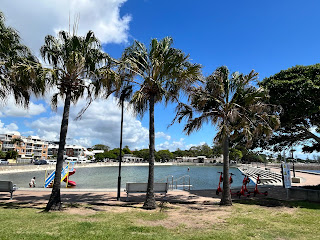February 26, 2024
Day 6: Port Arthur


Today we visited the Port Arthur Historic Site. It is one of the best convict/ prison sites in Australia and is a UNESCO World Heritage Site. The Port Arthur site was described as "the best surviving examples of large-scale convict transportation and the colonial expansion of European powers through the presence and labour of convicts." From 1833 to 1877, it was the destination of those deemed to be the most hardened convicts from Britain, or those who had reoffended once they had been transported to Australia. Over 12, 000 convicts served time at Port Arthur. The Port Arthur site developed over the 40 years of operation and the tour gives you a sense its evolution.
Upon arrival , we did a short boat trip in the bay where the site sits. The ride gives you a sense of the geography , and also points out two very important islands, that lie close by.
Point Puer, pictured below, was where juveniles males were sent to serve their time. It wasn't only adult men that were transported as convicts but also boys, some as young as nine years old. From 1834 to 1848, boys were housed on this island and kept separate from the adult male population. It was hoped that these boys could be reformed to be useful members of the new colonial society. It was hoped that by separating them from the adult convicts, they would have a better chance to be reformed. Boys were put to work, but also received training in the trades, rudimentary education and religious instructions.

Almost directly across from Point Pier is Dead Island. It served as the cemetery for Port Arthur. Many convicts died in prison, due to ill health, accidents, violence etc. They were transported to Dead Island and buried in unmarked graves. The convicts were denied recognition even in death.

The site of the actual Penitentiary , began as a flour mill. Originally prisoners were held in wooden barracks, further back from the shore. The idea ofqa mill was to be self sufficient in flour . As everyone got a bread ration, the original intention was that they would grow their own wheat, then mill it on site. Unfortunately, the climate here in Tasmania is not suitable for wheat. The mill idea was abandoned.The building was converted to a penitentiary. There were four floors. The best behaved prisoners were housed in a dorm like facility on the top floor. The third floor housed a dining hall , that was an also used as a school. There was a Catholic chapel, and even a library on site with over 13, 000 books. On the bottom floor were housed the most troublesome convicts. As seen, there cells were very tiny. The Penitentiary operated until the 1870s, then was abandoned. Two major fires nearly destroyed it in the 1890s. The Penitentiary site has been restored but not reconstructed. It was decided to leave it as it was after the fires, and eventually they stabilized the walls and foundations. Walking thru the "ruins" is an interesting experience . You can read some of the stories of the prisoners who were housed there. 



Two other very fascinating areas to explore are the Asylum and the Separate Prison. The Asylum pictured below, was built in in the mid 1860s and operated till its close in 1877. The institution housed those who were "lunatics" the phrase commonly used at the times . Unlike the rest of the facility, it was a bright airy space and the prescribed treatment here, was not hard labour as it was elsewhere but calm and quiet .

The Separate Prison, pictured below, was considered a model prison at the time. Its emphasis was not on hard labour, but on solitary quiet and reflection. The cells were small, and cramped, Strict silence was observed during the day, and convicts received one hour of exercise a day. The idea was that reflection and meditation by the convicts would help in their reformation. This prison was reserved for the most hardened and hard to reform convicts who came to Port Arthur. In many respects, shis solitary confinement principle was torture of the mind not body.


I really enjoyed my visit to the site. It was well laid out and the grounds are very well preserved. It does a wonderful job of trying to tell the story of the "prison" from all perspectives. I walked away with a better understanding of the "transportation of convicts", the numbers involved, and the stories of the people involved.
Finally, in the Visitor Centre, you can play "Discover Their Fate". You choose a card, go find their "drawer in the exhibit, and discover who the "convict" was and what happened to them. Lots of cards, and lots of stories. This is the fate of the "convict" I chose.





















